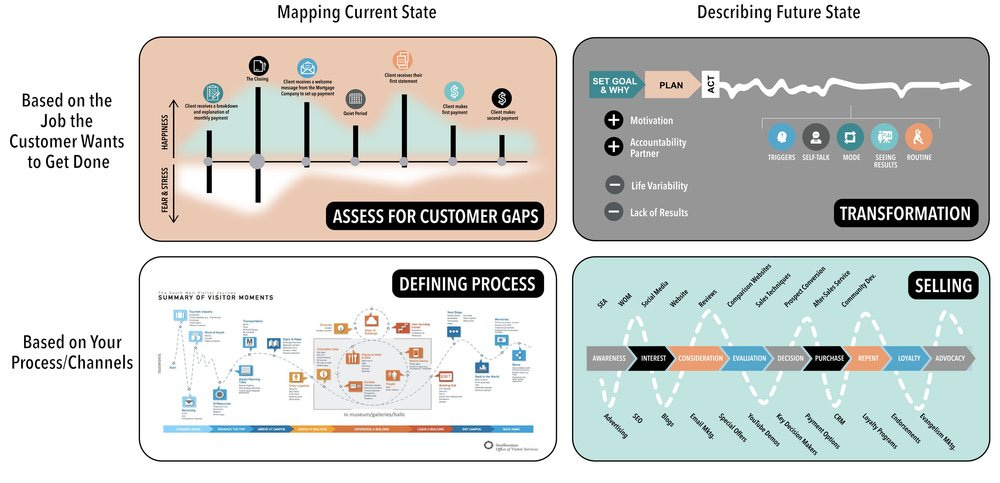Defining Customer Journey Mapping: Make Your Journey Maps Useful Again With a Few Simple Questions
One of the greatest things that experience strategists have done to transform companies into customer-centered businesses is to invent the journey map, but now, thanks to their pervasiveness, journey maps have become problematic in many organizations.
Why customer journey maps are important to companies.
Experience strategy focuses company resources on customer and employee needs to create value through experiences. When companies think about their customers as people who are going through a series of interactions with the company, it’s far easier for the people in the company to grasp and stay focused on customers’ (or employees’) needs, often called ‘jobs to be done.’ Journey mapping can guide mission, vision, and value proposition activities. They can be used as strategic plans. They can provide a general overview of the customer experience. And, they can also provide details for improving operations, innovation, features, benefits, messaging, and channel design.
What is the historical definition of customer journey maps?
Two decades ago most companies never mapped the journey their customers must take to engage with them. In the late 1990s design, researchers needed ways to describe the path that people followed to use new GUI software products. The journey map was born as a way to help them keep the focus on what the customer did rather than what the company wanted the customer to do.
The Nielsen Norman Group provides a good historical definition of journey mapping. They say “A journey map is a visualization of the process that a person goes through in order to accomplish a goal. In its most basic form, journey mapping starts by compiling a series of user actions into a timeline. Next, the timeline is fleshed out with user thoughts and emotions in order to create a narrative. This narrative is condensed and polished, ultimately leading to a visualization.”(nngroup.com)
What do people today mean by a customer journey map?
Today’s product and service development landscape are far more complex. While journey maps were originally built to help user experience and design thinkers describe the activities of customers, today, journey maps are used by leadership, marketing, sales, operations, business strategy, channel strategy, analytics and measurement, and third-party technology solutions. The problem is that each of these functions needs different things from their journey maps. As a result, over time, they have adapted journey maps to meet their needs. Journey Maps are no longer solely the domain of UX or CX.
A modern definition of a customer journey map
A modern journey map is a strategic document that helps companies focus on customer needs, often called ‘jobs to be done’, when making decisions about how to engage and support customers using the resources available to the company to create experiences. Most journey maps show a linear progression of phases or stages that customers move through. Other elements of journey maps may include:
Tasks
Emotions
Touchpoints
Barriers
Goals
Triggers
Mindset
Modes
Experiential elements
Data
Tools and environments
Behavioral factors
Pain points
Opportunities
Because companies and functional teams use the term “journey mapping” interchangeably there’s often misunderstanding about the goal and impact of the map. Journey mapping as an exercise will become useless unless companies align on the purpose of journey maps.
The questions you should be asking to get aligned on journey map objectives
Almost all journey maps (service design, marketing, UX, sales, process, etc.) can be categorized into one of four types. And you can determine the type of map you are developing based on two questions:
Will the journey map be based on the ‘job’ that the customer wants to get done or your processes/channels?
Will the journey map be a map of the customers’ experience with your solution in its current state or will you be describing the future state of a customer experience?
Defining Process:
If you are mapping your current state and the journey is principally focused on your processes and requirements, then the purpose of your journey mapping is to define your process.
Selling:
If you are mapping a future state and the journey is principally focused on your process or channels, then the purpose of your journey mapping is to guide your thinking about selling or convincing the customer of your merits.
Assess for Customer Gaps:
If your journey map is focused on how the customer gets their ‘job’ done and you are mapping their experience with your current offering, then you are using your journey map to assess gaps or pain points in the current experience.
Transformation:
If you are using insights from customers to align your future offering with the job(s) your customers want to get done, then you are journey mapping to guide business transformation. This type of mapping will help lead your organization to innovate across different silos in a way that teams can understand.
Experience Maps (Journey Maps 4.0)
We think it’s time to rethink ‘journey mapping’ and build new tools that address a post-pandemic, global customer world. This year in our Collaboratives Program we introduced the “experience map”, a whole new set of techniques and tools that build on what is best and most strategic about journey mapping while ensuring that the map accomplishes its intended purpose: customer-centricity. Experience mapping can help your company:
More accurately describe the customer’s actual experience.
Guide strategic decision-making regarding channel design and data requirements
Address the ‘dynamic’ between individual customers and their families and friends
Focus the company on the real job the customer wants the experience to get done
Motivate the customer
Zoom in on specific interactions that matter to customers
Describe situations that influence your customer
Want to learn more? Reach out to us HERE and we will show you how to harness the power of Experience Mapping for your company.





